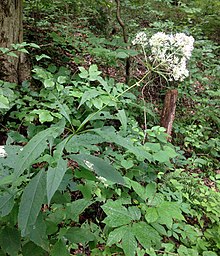| Eutrochium purpureum | |
|---|---|

| |
| Conservation status | |
 Secure (NatureServe) | |
| Scientific classification | |
| Kingdom: | Plantae |
| Clade: | Tracheophytes |
| Clade: | Angiosperms |
| Clade: | Eudicots |
| Clade: | Asterids |
| Order: | Asterales |
| Family: | Asteraceae |
| Genus: | Eutrochium |
| Species: | E. purpureum |
| Binomial name | |
| Eutrochium purpureum (L.) E.E. Lamont | |
| Synonyms | |
| |
Eutrochium purpureum, commonly known as purple Joe-Pye weed or sweetscented joe pye weed, is an herbaceous perennial plant in the family Asteraceae. It is native to eastern and central North America, from Ontario east to New Hampshire and south as far as Florida, Louisiana, and Oklahoma.
Description
Eutrochium purpureum is a clump-forming herb that grows to 1.5–2.4 meters (4.9–7.9 ft) tall and about 1.2 meters (3.9 feet) wide. Plants are found in full sun to part shade in mesic to wet soils. Stems are upright, thick, round, and purple, with whorls of leaves at each node. As the plant begins to bloom the stems often bend downward under the weight of the flowers. The leaves grow to 30 cm (12 in) long and have a somewhat wrinkled texture. The purplish flowers are produced in large loose, convex shaped compound corymbiform arrays. Plants bloom mid to late summer and attract much activity from insects that feed on the nectar produced by the flowers.
Taxonomy
Eutrochium purpureum shows a high amount of variability, and up to two or three varieties are currently recognized by current botanical authorities. They differ based in leaf shape, leaf pubescence, and achene glandularity. The precise delineation of these varieties is difficult due to integration between them. The commonly recognized varieties are:
- Eutrochium purpureum var. carolinianum- Southeastern Piedmont
- Eutrochium purpureum var. holzingeri- Midwestern
- Eutrochium purpureum var. purpureum- Widespread in eastern North America
This species hybridizes readily with other species of Eutrochium and where this species and those species overlap in distribution the resulting plants can be difficult to resolve to a specific taxon.
Ecology
Many species of butterflies, moths, bees, and flies visit the flowers.
It is larval host to the eupatorium borer moth (Carmenta bassiformis), the red groundling moth (Perigea xanthioides), the ruby tiger moth (Phragmatobia fuliginosa), and the three-lined flower moth (Schinia trifascia).
The larvae of Calycomyza flavinotum, a leaf miner fly, create blotch-shaped mines on the leaves.
Cultivation
Eutrochium purpureum is sometimes cultivated and has escaped from cultivation in parts of New Zealand.
References
- "NatureServe Explorer 2.0". explorer.natureserve.org.
- "Eutrochium purpureum". The Global Compositae Checklist (GCC) – via The Plant List. Note that this website has been superseded by World Flora Online
- "Eutrochium purpureum". Tropicos. Missouri Botanical Garden.
- "Eutrochium purpureum (purple Joe-Pye weed)". Go Botany. New England Wildflower Society. Retrieved 2018-04-07.
- NRCS. "Eutrochium purpureum". PLANTS Database. United States Department of Agriculture (USDA). Retrieved 1 July 2016.
- "Eutrochium purpureum". County-level distribution map from the North American Plant Atlas (NAPA). Biota of North America Program (BONAP). 2014.
- Weakley, Alan (2020). "Flora of the Southeastern United States".
- Sorrie, Bruce (2010-09-10). "A new variety of Eutrochium purpureum (Eupatorieae: Asteraceae)" (PDF). Phytoneuron. 2010–43: 1–6. Retrieved 2022-01-07.
- Lamont, Eric E. (2006). "Eutrochium purpureum". In Flora of North America Editorial Committee (ed.). Flora of North America North of Mexico (FNA). Vol. 21. New York and Oxford: Oxford University Press – via eFloras.org, Missouri Botanical Garden, St. Louis, MO & Harvard University Herbaria, Cambridge, MA.
- ^ Wilhelm, Gerould; Rericha, Laura (2017). Flora of the Chicago Region: A Floristic and Ecological Synthesis. Indiana Academy of Sciences.
- The Xerces Society (2016), Gardening for Butterflies: How You Can Attract and Protect Beautiful, Beneficial Insects, Timber Press.
- Webb, C.J.; Sykes, W.R.; Garnock-Jones, P.J. (June 2004). "Eupatoriadelphus purpureus". Flora of New Zealand. Retrieved 2008-01-28.
- "Botanica. The Illustrated AZ of over 10000 garden plants and how to cultivate them", p 359. Könemann, 2004. ISBN 3-8331-1253-0
| Taxon identifiers | |
|---|---|
| Eutrochium purpureum |
|
| Eupatorium purpureum |
|
